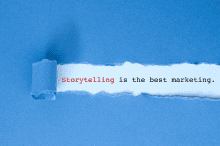As a marketer, we understand the importance of creating a memorable brand that resonates with your target audience. However, with so many brands vying for attention, standing out from the crowd can be challenging. One way to make your brand more memorable and impactful is through storytelling. In this article, we’ll explore the art of brand storytelling and how it can help you connect with your audience on a deeper level.
What is Brand Storytelling?


Brand storytelling is the art of using a narrative to communicate your brand’s values, personality, and unique selling proposition. It’s about creating a story that engages and connects your audience with your brand. A brand story is not just a marketing tool; it’s a way to communicate your brand’s purpose and mission.
Benefits of Brand Storytelling
Brand storytelling is a powerful tool for businesses to connect with their customers on an emotional level, and it offers several benefits, including:
1. Builds brand identity: Brand storytelling helps create a unique identity and personality for a brand, making it stand out in a crowded marketplace. By telling a compelling story, brands can differentiate themselves from their competitors and establish a clear position in the minds of their customers.
2. Enhances brand recall: Stories are easier to remember than facts or statistics. By using storytelling techniques, brands can create a memorable experience for their customers, making it easier for them to recall the brand when purchasing.
3. Increases customer engagement: Brand storytelling helps build an emotional connection with customers, making them more engaged with the brand. Engaged customers are likely to remain loyal to the brand, recommend it to others, and even become brand advocates.
4. Provides a competitive advantage: In today’s competitive marketplace, finding ways to stand out is essential. By storytelling, brands can differentiate themselves from their competitors and create a unique brand experience that sets them apart.
5. Conveys brand values: Stories are a powerful way to communicate a brand’s values and beliefs. By telling stories that align with the brand’s values, businesses can attract customers who share those values and create a sense of community around the brand.
6. Creates a connection with customers: Brand storytelling is an effective way to connect emotionally with customers. By sharing stories that resonate with their customers’ experiences and emotions, brands can create a sense of empathy and understanding, leading to stronger customer relationships.
Brand storytelling is a valuable tool to help businesses build stronger connections with their customers, differentiate themselves from competitors, and create a unique brand experience.
The Psychology of Storytelling in Marketing


The power of storytelling lies in its ability to tap into the human psyche. Stories activate the parts of our brains responsible for emotions and memory, making them more memorable and impactful than just presenting facts and figures.
When you tell a story, you create a mental image in the listener’s mind, which helps them remember the information better. Additionally, stories evoke emotions, which can help you make a deeper connection with your audience.
Elements of a Great Brand Story
A great brand story can be a powerful tool for building brand identity, connecting with customers, and differentiating your brand from competitors. Here are some elements of a great brand story:
1. Authenticity: A great brand story should be authentic and genuine to the brand’s values, history, and culture. It should honestly reflect who the brand is and what it stands for.
2. Emotional connection: A great brand story should evoke emotions and connect with the audience more deeply. It should resonate with the audience’s values, desires, and aspirations.
3. Consistency: A great brand story should be consistent across all touchpoints and communications channels. It should reinforce the brand’s core message and values.
4. Memorable: A great brand story should be unique and easy to remember. It should be concise and compelling and use language that resonates with the audience.
5. Differentiation: A great brand story should differentiate the brand from its competitors. It should highlight the brand’s unique selling proposition and what sets it apart from other brands in the same space.
6. Relevance: A great brand story should be relevant to the audience and the market. It should address the audience’s needs, pain points, and aspirations.
7. Visual appeal: A great brand story should have a visual appeal that enhances the story and communicates the brand’s values and identity. It should use visuals consistent with the brand’s visual identity and style.
8. Simplicity: A great brand story should be simple and easy to understand. It should avoid jargon, technical terms, and complicated language that may confuse or alienate the audience.
A great brand story should be authentic, emotional, consistent, memorable, differentiated, relevant, visually appealing, and simple, connecting with the audience and communicating the brand’s values and identity.
Crafting Your Brand Narrative


To craft your brand narrative, you must start by defining your brand’s values and mission. What is your brand’s purpose, and what do you stand for? What are your unique selling points, and how do they differentiate you from the competition?
Once you clearly understand your brand’s values and mission, you can start to develop your brand story. Think about the hero of your account and what challenges they face. What is the turning point for your brand’s success, and what is the story’s moral?
You must be authentic and genuine to your brand’s values when crafting your brand narrative. Don’t try to be something you’re not, as your audience will see through it. Instead, focus on what makes your brand unique and special.
How to Effectively Talk About Your Brand


Once you have crafted your brand narrative, you must effectively communicate it to your audience. One way to do this is through your brand’s messaging and visual identity and through your personal contribution by getting in touch with your audience. Your brand’s messaging should reflect your brand story, using language and tone that resonates with your audience.
Your personal and visual identity should also reflect your brand story, using structured introductory videos, colours, typography, and imagery that convey your brand’s personality and values. Your website, social media channels, and other touchpoints should all communicate your brand story consistently and effectively.
Tips for Telling Your Brand Story


Telling your brand story is integral to creating a connection with your audience and building a solid brand. Here are some tips to help you effectively tell your brand story:
1. Know your audience: Understanding who your audience is and what they value is vital to crafting a compelling brand story that resonates with them.
2. Start with your why: Begin your brand story by explaining why your company exists and what problem it solves. This will help your audience understand the purpose behind your brand.
3. Be authentic: Your brand story should reflect your company’s values, personality, and mission. Don’t try to be someone you’re not, as it can come across as inauthentic and damage your credibility.
4. Use emotion: Emotions are a powerful tool in storytelling. Use them to connect with your audience and make your brand story more memorable.
5. Show, don’t tell: Instead of telling your audience about your brand, show them through visuals, videos, and real-life examples. This will make your brand story more engaging and memorable.
6. Be consistent: Ensure your brand story is consistent across all channels and touchpoints. This will help build brand recognition and strengthen your brand identity.
7. Keep it simple: Your brand story should be easily understood and communicated. Avoid jargon or overly complicated language that could confuse or turn off your audience.
Following these tips can effectively tell your brand story and create a deeper connection with your audience.
Best Practices for Brand Storytelling in Marketing: Lessons from Top Brands
Brand storytelling has become an increasingly popular and effective marketing strategy for companies looking to connect with their customers more deeply. Here are some best practices for brand storytelling in marketing, as exemplified by top brands:
1. Be Authentic: People respond to real stories that resonate with them emotionally. Brands like Patagonia, TOMS, and Warby Parker have built their brand narratives around their social and environmental causes, and they make sure their messaging aligns with their actions.
2. Use Emotion: Great stories connect with people on an emotional level. Companies like Coca-Cola, Apple, and Nike are masters at using emotion to create powerful brand stories that inspire and motivate their audiences.
3. Keep it Simple: Compelling stories don’t have to be complex. Brands like Airbnb and Uber have built their success on simple levels that explain their value proposition and why they exist.
4. Focus on the Customer: Brand stories should be about the customer, not the company. Brands like Amazon, Zappos, and Nordstrom have built their brand narratives around their customers and needs, demonstrating how they solve problems and improve their customers’ lives.
5. Create a Consistent Narrative: A great brand story should be consistent across all touchpoints, including social media, advertising, and customer service. Brands like Coca-Cola and McDonald’s have maintained a consistent brand narrative for decades, using their stories to build strong emotional connections with their customers.
6. Use Visuals: Visual storytelling can be a powerful tool for brands. Companies like GoPro, Red Bull, and Instagram have built their brand narratives around visual storytelling, using images and videos to create emotional connections with their audience.
7. Be Flexible: Great brand stories can evolve. Brands like Starbucks and Dove have adapted their stories to reflect changing customer preferences and societal trends while staying true to their core values.
By following these best practices, brands can use storytelling to create stronger emotional connections with their customers, differentiate themselves from competitors, and build a loyal customer base.
Conclusion
In conclusion, brand storytelling is a powerful marketing tool to help you create a memorable and impactful brand. By crafting a compelling brand narrative that resonates with your audience, you can create an emotional connection that leads to loyalty and trust. To tell your brand story effectively, focus on authenticity, simplicity, and emotional impact. Use your brand’s messaging and personal/visual identity to communicate your account consistently and effectively across all touchpoints.
Are you looking to build your brand? Then, check out Markitome to learn more!



We hope you’re enjoying reading our blogs… Don’t forget to secure your browsing experience with Nord VPN. Click the banner below to learn more
More To Explore
Redefining Digital Marketing in 2024: 10 Game-Changing Trends
In the ever-evolving world of digital marketing, staying ahead of the curve is essential. As we approach 2024, it’s crucial to be aware of the
SEO Mania-7 Proven Strategies for Explosive SEO Growth in 2024
Understanding the Importance of SEO in 2024 In the ever-evolving world of SEO, staying ahead of the curve is crucial to your online success. As